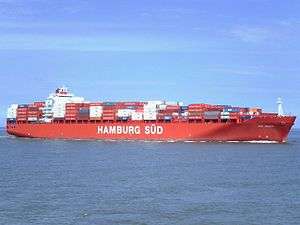Rio Negro (ship)
Rio Negro is a container ship owned by A.P. Moller Singapore Pte. Ltd.[3] and operated by Maersk Line AS[2]. The 286.45-metre (939.8 ft) long ship was built at Daewoo Shipbuilding & Marine Engineering[1] in Okpo, South Korea in 2008. Originally owned by Rio Negro GmbH & Co KG, a subsidiary of Hamburg Süd[2], she has had two owners and been registered under two flags.
 Container ship Rio Negro | |
| History | |
|---|---|
| Name: | 2018–present: Rio Negro[2] |
| Owner: | A.P. Moller Singapore Pte. Ltd.[3] |
| Operator: | Maersk Line AS[2] |
| Port of registry: | Singapore as of 28 March 2018[1] |
| Route: | Hamburg Süd Australia/New Zealand South East Asia (SENZ-Southern Loop) liner service[4] |
| Identification: |
|
| Status: | In service[5] |
| Name: | 2008–present: Rio Negro[1] |
| Owner: | Rio Negro GmbH & Co KG[2] |
| Operator: | Columbus Shipmanagement GmbH C/O Hamburg Suedamerikanische Dampfschiffahrts-Gesellschaft KG[2] |
| Port of registry: | Germany as of 11 January 2008[2] |
| Builder: | Daewoo Shipbuilding & Marine Engineering[1] |
| Laid down: | 16 June 2008[1] |
| Completed: | 4 November 2008[1] |
| Identification: | IMO number: 9357975 |
| General characteristics | |
| Class and type: | ABS A1, Container Carrier, AMS, ACCU; RRDA, BWE, Ice Class D0 , UWILD, TCM, PMP[1] |
| Tonnage: | 73,899 GT[1] |
| Length: | 286.45 m (939.8 ft)[1] |
| Beam: | 40 m (131.2 ft)[1] |
| Depth: | 24.2 m (79.4 ft)[1] |
| Ice class: | D0 |
| Installed power: | Hyundai Heavy Industries Engine and Machinery Division 8RTA96C[6] |
| Speed: | 24.7 knots[7] |
| Capacity: | 80,454.6 tonnes deadweight (DWT)[1] |
The vessel is one of three ships of the Rio class built for Hamburg Süd by Daewoo Shipbuilding & Marine Engineering in 2008.[8][9]
Construction
Rio Negro had its keel laid down on 16 June 2008[1] at Daewoo Shipbuilding & Marine Engineering[1] in Okpo, South Korea. Its hull has an overall length of 286.45 metres (939.8 ft).[1] In terms of width, the ship has a beam of 40 metres (130 ft).[1] The height from the top of the keel to the main deck, called the moulded depth, is 24.2 metres (79 ft).[1]
The ship's container-carrying capacity of 5,905 twenty-foot equivalent units (TEU) (5,905 20-foot shipping containers)[7] places it in the range of a Post-Panamax container ship.[10] The ship's gross tonnage, a measure of the volume of all its enclosed spaces, is 73,899.[1] Its net tonnage, which measures the volume of the cargo spaces, is 39,673.[1] Its total carrying capacity in terms of weight, is 80,454.6 long tons deadweight (DWT).[1]
The vessel was built with a Hyundai Heavy Industries Engine and Machinery Division 8RTA96C[6] main engine, which drives a controllable-pitch propeller. The 8-cylinder engine has a Maximum Continuous Rating of 45,760 kW with 102 revolutions per minute at MCR. The cylinder bore is 960mm. The ship also features 4 main power distribution system auxiliary generators, 2 at 5,428.5-kilowatt (7,279.7 hp) each, and 2 at 4,071.4-kilowatt (5,459.8 hp).[6] The vessel's steam piping system features an Aalborg CH 8-4500 auxiliary boiler, as well as an Aalborg AQ-2 exhaust gas boiler.[6]
Construction of the ship was completed on 4 November 2008.[1] As of 2018, the ship is classified by the ABS with the code "A1, Container Carrier, AMS, ACCU; RRDA, BWE, Ice Class D0 , UWILD, TCM, PMP[1]", meaning that it was constructed under the supervision of a recognized classification society, that the construction complies with the society's rules, and that it is classed as a general cargo carrier and container ship.[1]
Notes
- "ABS Record - General Characteristics", 2018.
- "Equasis", 2018.
- "ABS Record - Owner/Manager", 2018.
- "Australia/New Zealand South East Asia (SENZ-Southern Loop) liner service", p. 9-10, 2018.
- "United States Coast Guard PSIX", 2018.
- "ABS Record - Machinery", 2018.
- "Port of Hamburg - Rio Negro", 2018.
- "Hamburg Süd History", 2018.
- "Fleetmon Rio Class", 2018.
- MAN Diesel & Turbo, "Propulsion Trends in Container Vessels", 2009, pp.8-9.
References
- Det Norske Veritas (January 2011). "Part 1, Chapter 2: Class Notations". Rules for the Classification of Ships (PDF). Høvik, Norway: Det Norske Veritas AS. Archived from the original (PDF) on 2012-01-21. Retrieved 2011-08-05.
- International Maritime Organization (2002). "International Convention on Tonnage Measurement of Ships, 1969". International Maritime Organization. Archived from the original on 2008-01-16. Retrieved 2008-03-23.
- United Nations Conference on Trade and Development (UNCTAD) (2008). Review of Maritime Transport, 2008 (PDF). New York and Geneva: United Nations. ISBN 978-92-1-112758-4.